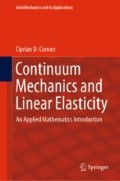Abstract
Our next main task will be to investigate how the displacement field can be recovered if the infinitesimal stress or strain tensors are known. Although the scope of this question turns out to be rather broad, the gist of what we are about to do is contained in the following basic scenario. Assume that \(D\subset \mathbb {E}^2\) is an open set and \(g_j\in C^1(D)\) are given scalar fields (\(j=1,2\)); we are interested in finding a new scalar field \(\phi \in C^2(D)\) such that \(\phi _{\,,\,1} = g_1\) and \(\phi _{\,,\,2}=g_2\) in D. Of course, if such a field exists then \(\phi _{\,,\,12}=\phi _{\,,\,21}\) or \(g_{1,\,2}=g_{2,\,1}\). This latter condition is necessary for the existence of a \(\phi \) having the foregoing stated properties. To put it differently, the obtained condition ensures the compatibility (or consistency) of the two equations satisfied by \(\phi \). It is fairly straightforward to show that under certain circumstances the condition is also sufficient. We note in passing that if \(\varvec{g}:=(g_1,\,g_2,\,0)\), the compatibility condition in this basic case can be cast as \(\varvec{\nabla }\wedge \varvec{g}= \varvec{0}\). The extension of these naive calculations to vector and tensor fields (as explained in the next sections) leads naturally to a discussion of the Beltrami–Michell equations and the concept of Weingarten-Volterra dislocation in multiply connected linearly elastic bodies.
Access this chapter
Tax calculation will be finalised at checkout
Purchases are for personal use only
Notes
- 1.
The deformation is exaggerated here in order to help make the point.
- 2.
In Mathematics, an equivalence relation ‘\(\sim \)’ on a set \(\mathcal {X}\) is a binary relation that satisfies three axioms: \((\forall )\) A, B, \(C\in \mathcal {X}\), (i) \(A\sim A\); (ii) if \(A\sim B\) then \(B\sim A\); (iii) if \(A\sim B\) and \(B\sim C\) then \(A\sim C\). An equivalence relation provides a partition of the underlying set \(\mathcal {X}\) into disjoint subsets called equivalence classes. Any two elements in one of such equivalence classes are equivalent to each other; they are indistinguishable from the point of view of ‘\(\sim \)’.
- 3.
Here and subsequently, \(\varvec{X}\) is kept fixed and the differentials are taken with respect to \(\varvec{Y}\). Also, the notation \(\varvec{\nabla }_{\varvec{Y}}\) will be used to indicate that the gradient is calculated relative to \(\varvec{Y}\).
- 4.
Note that, in general, \((\varvec{\nabla }\wedge \varvec{A})_{\times } =-\varvec{\nabla }|\varvec{A}|+\varvec{\nabla }\cdot \varvec{A}^T\) for any second-order tensor \(\varvec{A}\), not necessarily symmetric.
Bibliography
Adams RA (1999) Calculus: a complete course. Addison-Wesley, Longman Ltd., Ontario
Salas SL, Hille E (1995) Calculus: one and several variables. Wiley, New York
Chou PC, Pagano NJ (1967) Elasticity: tensor, dyadic, and engineering approaches. D. Van Nostrand Company Inc, Princeton, New Jersey
Fraeijs de Veubeke BM (1979) A course in elasticity. Springer, New York
Gurtin ME (1972) Theory linear theory of elasticity. In: Truesdell C (ed) Handbuch der Physik. Springer, Berlin, pp 1–273
Love AEH (2011) A treatise of the mathematical theory of elasticity. Dover Publications, Mineola, New York
Malvern LE (1969) Introduction to the mechanics of a continuum medium. Prentice-Hall Inc, Englewood Cliffs, New Jersey
Nadeau G (1964) Introduction to elasticity. Holt, Rinehart and Winston Inc, New York
Teodosiu C (1982) Elastic models of crystal defects. Springer, Berlin
Author information
Authors and Affiliations
Corresponding author
Rights and permissions
Copyright information
© 2020 Springer Nature B.V.
About this chapter
Cite this chapter
Coman, C.D. (2020). Compatibility of the Infinitesimal Deformation Tensor. In: Continuum Mechanics and Linear Elasticity. Solid Mechanics and Its Applications, vol 238. Springer, Dordrecht. https://doi.org/10.1007/978-94-024-1771-5_6
Download citation
DOI: https://doi.org/10.1007/978-94-024-1771-5_6
Published:
Publisher Name: Springer, Dordrecht
Print ISBN: 978-94-024-1769-2
Online ISBN: 978-94-024-1771-5
eBook Packages: EngineeringEngineering (R0)

